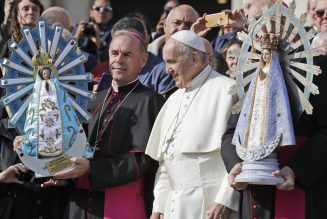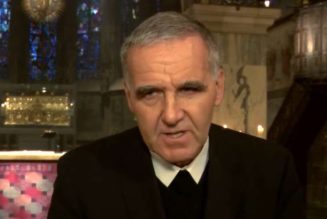
Ciao amici,
Greetings from Rome and the synod on synodality.
We’re entering into the home stretch now, with just a few more days of deliberations, and then the votes on the synod’s interim report.
At this stage, borrowing from the late Arizona congressman Morris Udall, one bishop told me that “everything’s been said already, but not everybody has said it.”
So the synod goes on. In fact, I’ve got a lot to say about the synod.
But first let me tell you about my Roman nemesis. He wants to take me out, I’m pretty sure. But this has nothing to do with Vatican finance, exposing corruption, or any other kind of reporting. At least I don’t think it does.
I’ve been coming to Rome on business for at least the past 10 years, usually at least once a year — but in the years before COVID, and again in recent years, I’ve come two, three, or even four times a year.
I nearly always stay in the same hotel; it’s comfortable, familiar, and family-owned. I like it there, very much.
Now, I knew they had a cat, who usually keeps clear of guests. But until this trip, I’d never known about the hotel’s house tortoise.
I met him last week.
I had gone out to the hotel’s terrace to sit at a little table in the sun and do some work, as I’ve done many times before. But as I booted up my laptop, I heard a clomping sound behind me. It got faster and closer as I got started on my work.
And then, just below my feet, was a tortoise. He was the size of a salad plate, with a green scalloped shell and the distinctive curved neck of a land turtle.
I thought I’d pet him. I assumed he’d be much like the kind of tortoise you see in cartoons — dopey, affable, and prepared to win a race against some intemperate hare.
But I learned that this tortoise didn’t want me on his terrace.
He came straight for my shoes, with a surprisingly snappy bite and a sharp beak. He kept snapping his jaws and biting my shoes until I got out of there.
Let me be clear: A small tortoise chased me off the terrace. Not once, but over the next few days, he chased me off that terrace many times. I have to accept that about myself.
Again, I really like our hotel. I respect the hoteliers, and they’re kind to us. I’ll like our hotel even if my tortoise nemesis keeps me off the terrace. And right now, that’s how things are looking.
I did some reading, and I’ve learned that male tortoises can be territorial. And when they perceive that someone is a threat to their territory, they’re fearless.
But I don’t entirely understand the dynamic between this tortoise and me. I don’t know why I’m a threat to him. I have no designs on his territory.
Ed told me that he’d always thought the tortoise was ceramic. Other friends who stay at the same hotel say they’ve noticed the tortoise moving, but he’s never gone near them. Some say they like having him around. I’d like for the tortoise and me to get to that place. But the tortoise does not like having me around.
First I thought maybe he didn’t like the shoes I’d been wearing. So I went out on the terrace with a dress pair on my feet, and I put down my regular shoes as a decoy. The tortoise was not fooled. He crawled over the decoy pair. Then he looked me in the eye, and ran straight at the oxfords on my feet.
This weekend, I brought him some grapes. They were meant as an offering — a gesture of friendship. I figured if the tortoise took them as a sign of fealty, that’d be fine too. I don’t mind if he thinks he’s the boss, as long as he lets me sit on the terrace.
The tortoise ate one bite from a grape, and then came for my toes. I got out of there.
I’ve got another five days in Rome. I’m aiming to find a path of reconciliation here, I guess.
Because maybe the real synodality is the tortoises we’ve met along the way?
The news
Here at the synod on synodality, I’ve been struck by the diversity of rhetoric used among participants and organizers to actually describe the synod itself.
Some talk about the synod in terms of ecclesial reform. Some talk about it in terms of ecclesial renewal — a new invitation to the Holy Spirit.
And some talk about the synod in terms of a revolution — talking about an entirely new way of “being Church.”
I think that kind of rhetoric has contributed to the broad mistrust in the synod among a swath of Catholics in many countries. Here’s an analysis about that.
—
Next: The synod on synodality is technically, as you probably know, a synod of bishops. But nearly 25% of voting members are non-bishops — priests, religious, and other lay Catholic delegates from around the world.
Here in Rome, there has been some pushback in the press room about the prospect that a synod of bishops could see its resolutions decided by non-bishop votes, if the bishops themselves are largely divided on some issue.
This analysis explains something about the history and governance of synods, and how both Vatican officials and critics understand the issue of lay voting at the synod on synodality.
Rest assured, this issue will continue to be raised, both this week and at the synod’s second session next year.
Cardinal Christoph Schonborn told reporters yesterday that, for his part, he “can’t see the problem” with the prospect of lay votes deciding an issue at an episcopal synod.
That took me by surprise — even if you don’t agree with the critics, their concern seems straightforward enough.
So you can read about all of that right here.
—
Now here’s something cool: Each Saturday of October, as the synod on synodality rumbles on, the Vatican has hosted a candlelight rosary procession around St. Peter’s Square.
I attended the rosary procession last Saturday, and talked with participants, both Catholic and non-Catholic, about why they’d come.
I also spoke with synod delegate Archbishop Charles Palmer-Buckle of Ghana, who told me:
“I don’t think we must change the Church to fit us. We must rather fit ourselves to Jesus Christ and what he wants of us, through the help of the Church.”
Read more of what he, and others, had to say, right here.
At The Pillar, we got curious how serious the situation in Essen really is, so we crunched some numbers.
The diocese appears to be in statistical freefall:
Of course, why it’s in a freefall is the critical question. And The Pillar’s Luke Coppen gave some important history, and context, to what’s eating the Diocese of Essen.
—
Finally, a major new study of the Catholic Church in Latin America has highlighted a decline in the number of baptisms and other sacraments. On the other hand, the study also showed that the number of priests in the Central America and Mexico region doubled between 2000 and 2020.
Read all about it, right here.
The synodal revolution will not be televised
I’ve been thinking this week about two related concepts in television writing — the “bottle episode” and the “departure episode.”
A “bottle episode” is the kind of show in which several of the main characters spend all their time “bottled up” in one location, usually facing some vexing conflict or problem, and often going a bit mad in the process.
The most famous bottle episode came in the second season of Seinfeld.
It was called “The Chinese Restaurant,” because the entire thing played out while Jerry, Elaine, and George waited for a table at a Chinese restaurant. George and Jerry spent the episode going crazy over private neuroses, while Elaine got increasingly irritable, and hungry, as they waited for seats.
Here’s a clip:
The drama of a good bottle episode — like Community’s “Cooperative Calligraphy” — is watching the characters ping off each other in a confined space, sometimes descending into something of a caricature of their ordinary selves.
Related to that is the concept of a “departure episode.”
A “departure episode” is a stand-alone teleplay of an otherwise serialized and episodic TV show — it is set apart from the main arc, so that it doesn’t feel like the rest of the rest of the series.
It has a kind of interior wholeness, which is why it can be watched without much tie-in to the broader story being told.
It’s a self-conscious break from the usual story arc.
Famous “departure episodes,” like the West Wing’s “Isaac and Ishmael” or The Sopranos’ “Pine Barrens,” don’t tie very much to the overall narrative of the series — if you see them, that’s fine, if you miss them, you can still follow along with the rest of the show, because they don’t contain any points for the broader arc.
(Here I should say that The Sopranos is a show with a moral landscape very different from our own; viewer discretion is advised).
In fact, even if you don’t know much about its show at all, you can still follow a departure episode, because of the way it tells a self-contained story.
Sometimes TV writers will do my favorite thing: They’ll craft a bottle episode that is also a departure episode — you’ve got a few characters, in a tightly contained universe, with a self-contained set of stories.
In my opinion, some of the best bits of TV are when you’ve got the combination of a departure episode and a bottle episode — usually that makes for very good storytelling, which is why the well-written Atlanta, from Donald Glover, regularly did iterations of this combo.
It’s like a fast-moving one-act play featuring a set of TV characters, playing a bit outside their usual roles.
Now, here’s why I am telling you all this:
The synod on synodality is definitely an ecclesiastical bottle episode. Think about it: Seated in the synod hall each day, you’ve got a relatively small cast of characters — the 360 voting members of the assembly — bouncing against each other in interesting and unexpected ways. As the synod goes into its third week, some of those characters begin offering increasingly unusual takes on what they’re up to, and others are getting frustrated by the bureaucratic monotony of it all, or by the reported lack of available coffee in the synod hall.
One setting? The Vatican. Limited cast? The delegates. A set of intertwined and interrelated narratives and priorities, some serious, some trivial? Yep.
Yep. Yep. Yep. It’s a bottle episode.
But is it a “departure episode?” That’s a far more important question. Will the synod on synodality have any long term effect on the Church’s story?
Will it amount to anything at all, or is it a brief departure from the major developing plotlines facing the Church — things like widespread institutional disaffiliation, the fallout from the sexual abuse scandal, an increasingly polarized theological landscape, and major demographic shifts in the Church’s global constitution?
Will it have a major on the Church’s mission and identity — the proclamation of the Kingdom of God?
For myself, I’m skeptical this synod will have lasting impact on those things.
The 2018 youth synod was certainly a “departure episode.”
The delegates came, they talked, they debated, people agonized over various things, and then they went home, with nothing of significance happening as a result, and almost no one discussing it when it was over.
The 2019 Amazon synod was almost a “departure episode.”
For all the tumult and drama and scandal of that meeting, the final post-synodal apostolic exhortation made few concrete changes in the life of the Church.
They came, they talked, some of them said outrageous things, the statue got thrown in the river, people went home, and then the pope made almost no significant long-term changes to the life of the Church. Perhaps the only one — the reason it was not a complete “departure” — is that the pope established an “ecclesial conference” in the Amazon connected to the synod, a group of bishops responsible for encouraging synodality in the region.
By contrast, the 2015 family synod, from which sprung Amoris laetitia, was not a departure episode. It’s a central part of the story of the Church over the past 10 years; its subsequent policies have been the substance of debate since Amoris was promulgated in 2016, and have shaped the way people subsequently viewed the Francis pontificate.
Now, it’s possible that the pope will propose, after the second synod on synodality next year, the creation of some new consultative structures at the “continental level,” or at the level of episcopal conferences. He may create “ecclesial assemblies,” like the one in the Amazon, in other parts of the world. But that seems to be the most the synod will actually do.
While folks talked a lot about the synod taking up controversial issues, many organizers and participants now emphasize that this whole affair has been a good practice run of “synodal listening,” and that outcomes will be personal, not corporate.
It seems increasingly likely, at least to me, that many of the controversial proposals floated around the synod will not make it into the final document this month, much less into the pope’s eventual exhortation on synodality.
Sure, the document will probably offer nods in the direction of various ideological camps and agendas, but I’m told that the lion’s share of participants will push back if the document takes hard positions on controversial issues.
It’s my sense that the synod text will eventually be written with a mind towards offending no one who participates — and in that sense, it seems all but guaranteed to say very little.
There might be intense arguments in the next few days over both the synod document and the planned “Letter to the People of God” that the synodal assembly has said it will publish this week. And I do think that the synod interim document will include some controversial theological methodology, and it’s possible that the text will be weaponized as a tool in inter-ecclesial controversies over the next year.
But I’m increasingly convinced that after the 2024 synod — for all the money and time spent on this project — the word “synodality” will linger as a buzzword for a while, a shibboleth for some tribes, and that will be the sum of what all this actually amounts to.
Consultative leaders will continue to be consultative, and leaders who are not very consultative will continue doing their thing too. There will continue to be theological conflict in the Church, and the synod text will be weaponized in that conflict — but theological conflict is the watchword of our day, and would exist with or without the synod. I do not expect the synod will change the narrative by quelling that debate, either.
I could be wrong, but I think we’re looking mostly at both a “bottle episode” and a “departure episode” in the life of the Church— albeit one that’s taken a lot of time to produce, and will long leave an impression in the minds of Catholics around the world.
—
And since I’m talking about television, permit me another television metaphor.
I mentioned Seinfeld above — and if you’re old enough to have watched Seinfeld in its original run, you know that its genius lay in the perfect execution of modest ambitions.
Seinfeld was not a potboiler or a procedural. It wasn’t a character drama, no one ever really experienced personal growth, or even changed their minds.
The show was instead about four people who mostly sat around a table talking with each other, about whatever was on their minds.
And to a number of journalists I’ve spoken with, that’s increasingly what the synod on synodality feels like, at least to those of us observing the daily press briefings.
There might actually be a lot of deep, spiritual, and meaningful conversation going on in the synod hall. The delegates might actually be addressing the world’s deepest problems in focused spurts of spirited debate, applying the Gospel to complex challenges.
But you wouldn’t know much of that from the press hall, where each day, four or five participants are brought to a table, and each tells reporters how much they like the round tables used for synodal conversation, and how glad they are for the people in their small groups, and how much they’ve been impressed by their synodal listening.
But few gave any indication that the synod is a forum for substantive engagement on serious issues — at most, there is the sense that people are making known their points of view, but without concrete interlocution with those with whom they disagree.
But consider that Seinfeld was a show about people having lengthy conversations of little substance. That’s what made it “the show about nothing.”
And despite all the lead-up, some close observers in Rome are starting to wonder if that’s an apt comparison for the day-to-day of the synod hall.
If it’s more than that, the daily public briefings have not made the case, largely because they’ve given almost no detail on the deliberations. That kind of opacity is surprising, given that the Vatican’s synod on synodality was meant to demonstrate for the Church how to take up a more synodal style.
Again, make of that what you will.
The synod at the cross
Please allow me one more note on the synod.
When controversial issues come up in the dialogue surrounding the synod, or in the speeches I’ve read or heard about, I’m struck by what seems to me a clear dichotomy between approaches to the pastoral issues under debate. At the crux of that dichotomy is a question: Are we afraid of the Cross?
If we’re afraid of the Cross — if we don’t think anyone should have to find themselves at Calvary — we develop a broken pastoral theology, one that makes alleviating suffering the starting point of pastoral care, rather than starting from the truth of divine revelation.
That kind of pastoral care aims to soothe the suffering soul, but too often with panacea, not with the hard medicine that brings a person to a rightly ordered relationship with himself, and with God.
If we know that the path to intimacy with God runs necessarily through the Cross, then pastoral accompaniment means strengthening a fellow traveler for the journey, and encouraging him to keep to the narrow path.
That kind of pastoral care doesn’t obscure the Cross, because it usually comes from someone already with the Lord in his agony. It is fraternal — it doesn’t imagine it can take the Cross from anyone, but it knows that Christians help another to bear the weight.
The Cross is the locus of our sanctification. It should be a cause of joy. If we run from it, we can’t hope to share in the Lord’s resurrection.
Synodality means something about walking together. If that journey doesn’t begin on the via dolorosa, it’s hard to see much point.
Be assured of our prayers, and please pray for us. We need it.
And if you can, please become a paying subscriber to The Pillar. There’s a lot more Church to cover — we need you on the team:
Wish me luck with the tortoise.
Yours in Christ,
JD Flynn
editor-in-chief
The Pillar
Comments 37
Services Marketplace – Listings, Bookings & Reviews









